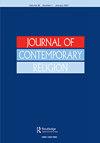成为犹太人,信仰耶稣:巴西福音派的犹太化
IF 0.6
3区 哲学
0 RELIGION
引用次数: 0
摘要
人类学理论的“沉重”部分。他指出了哪些部分是最繁重的,并鼓励对这些内容不感兴趣的读者跳过这些部分。也许它们吸引了文化人类学家,但它们主要是为了文字游戏而阅读文字游戏。在这些相对较短的章节中,我未能辨别出连贯的论点,也未能理解为什么一些人类学家选择以如此难以理解的方式写作。其他问题相对较小。有许多小错误。比亚莱基使用“世俗主义”作为世俗性、世俗化、非宗教、非宗教和所有非宗教事物的总称,这不是大多数学者理解这个词的方式。他错误地将盐湖寺描述为以前的寺庙遗址(67),偶尔会错误地使用“不受欢迎”等术语(同上)。最后,比亚莱基认为摩门教和超人类主义本质上是相容的(161)。由于摩门教神学,可能存在一些可能的联系,但作者确定这种兼容性的主要来源是那些找到了使其兼容的方法的个人——摩门教跨人类主义者的线人。如果作者采访或研究了其他不属于跨人文主义者的摩门教徒,这种论点会更加有力。总的来说,《造神机器》很有趣,因为它的主题是独一无二的——信奉冷冻学、奇点、技术和人类增强的摩门教徒。如前所述,这本书可能会更紧凑,更紧密的编辑会加强它,一个清晰可辨的总体论点会有所帮助。这本书在描述MTA及其成员时最为有力;当比亚莱基更普遍地讨论LDS教会时,微妙的错误更常见。然而,对于那些对摩门教或超人类主义感兴趣的人来说,这本书值得一读。本文章由计算机程序翻译,如有差异,请以英文原文为准。
Becoming Jewish, Believing in Jesus: Judaizing Evangelicals in Brazil
sections that are ‘heavy’ with anthropological theory. He indicates which parts are the most onerous and encourages readers who are not interested in that content to skip those sections. Perhaps they are engaging for cultural anthropologists, but they read largely as wordplay for the sake of wordplay. I failed to discern coherent arguments in these relatively short sections and to see why some anthropologists choose to write in such incomprehensible ways. Other problems are relatively minor. There are a number of small errors. Bialecki uses ‘secularism’ as a catch-all term for secularity, secularisation, nonreligion, irreligion, and all things that are not religion, which is not the way most scholars understand the term. He mistakenly describes the Salt Lake Tabernacle as a former temple site (67) and occasionally uses terms like ‘disfellowshipped’ erroneously (ibid). Finally, Bialecki suggests that Mormonism and transhumanism are inherently compatible (161). There may be some possible links thanks to Mormon theology, but the author’s primary source for determining this compatibility is individuals who have found a way to make them compatible—informants who are Mormon transhumanists. This argument would have been much stronger had the author interviewed or studied other Mormons who do not identify as transhumanists. Overall,Machines for Making Gods is intriguing because the subject matter is unique— Mormons who embrace cryonics, the singularity, technology, and human enhancement. As indicated, the book could be much tighter, closer editing would have strengthened it, and a clearly discernible overarching argument would have helped. The book is strongest when describing the MTA and its members; the subtle errors creep in more commonly when Bialecki discusses the LDS Church more generally. However, for those interested in either Mormonism or transhumanism, this book is worth the read.
求助全文
通过发布文献求助,成功后即可免费获取论文全文。
去求助
来源期刊

Journal of Contemporary Religion
RELIGION-
CiteScore
1.20
自引率
0.00%
发文量
59
期刊介绍:
Journal of Contemporary Religion is an international peer reviewed journal. Its purpose is to both document and evaluate the anthropological, sociological, psychological, and philosophical aspects of emerging manifestations of religiosity in any part of the world—whether within innovative movements or mainstream institutions. The term ''religion'' in the title of this journal is understood to include contributions on spirituality. Moreover, as the journal title suggests, the focus is on contemporary issues. Therefore, the editors of Journal of Contemporary Religion welcome submissions which deal with: classical topics in the study of religion, such as secularisation and the vitality of religion or traditional sectarian movements; more recent developments in the study of religion, including religion and social problems, religion and the environment, religion and education, the transmission of religion, the materialisation and visualisation of religion in various forms, new forms of religious pluralism, the rise of new forms of religion and spirituality, religion and the Internet, religion and science, religion and globalisation, religion and the economy, etc. theoretical approaches to the study of religion; discussions of methods in relation to empirical research; qualitative and quantitative research and related issues. The Journal includes reviews of books which reflect the above themes.
 求助内容:
求助内容: 应助结果提醒方式:
应助结果提醒方式:


